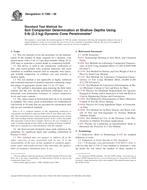Potřebujeme váš souhlas k využití jednotlivých dat, aby se vám mimo jiné mohly ukazovat informace týkající se vašich zájmů. Souhlas udělíte kliknutím na tlačítko „OK“.
ASTM D7380-08
Standard Test Method for Soil Compaction Determination at Shallow Depths Using 5-lb (2.3 kg) Dynamic Cone Penetrometer
Automaticky přeložený název:
Standardní zkušební metoda pro stanovení zhutnění půdy v malých hloubkách za použití 5-lb (2,3 kg), Dynamic Cone penetrometru
NORMA vydána dne 1.4.2008
Informace o normě:
Označení normy: ASTM D7380-08
Poznámka: NEPLATNÁ
Datum vydání normy: 1.4.2008
Kód zboží: NS-38322
Počet stran: 8
Přibližná hmotnost: 24 g (0.05 liber)
Země: Americká technická norma
Kategorie: Technické normy ASTM
Anotace textu normy ASTM D7380-08 :
Keywords:
compaction test, cone, cone penetrometer, construction control, dynamic cone penetration test, 5-lb DCP, soil compaction, percent compaction, soil density, water content, ICS Number Code 13.080.20 (Physical properties of soil), 93.020 (Earth works. Excavations. Foundation construction. Underground works)
Doplňující informace
| Significance and Use | ||||||||||||||||||||||
| p>The test method is used to assess the compaction effort of
compacted materials. The number of drops required to drive the cone
a distance of 3.25 in. (83 mm) is used as a criterion to determine
the pass or fail in terms of soil percent compaction.
The device does not measure soil compaction directly and requires determining the correlation between the number of drops and percent compaction in similar soil of known percent compaction and water content. The number of drops is dependent on the soil water content. Calibration of the device should be performed at a water content equal to the water content expected in the field. There are other DCPs with different dimensions, hammer weights, cone sizes, and cone geometries. Different test methods exist for these devices (such as D 6951) and the correlations of the 5-lb DCP with soil percent compaction are unique to this device. The 5-lb DCP is a simple device, capable of being handled and operated by a single operator in field conditions. It is typically used as Quality Control (QC) of layer-by-layer compaction by construction crew in roadway pavement, backfill compaction in confined cuts and trenches, and utility pavement restoration work. Note 2—The quality of results produced by this test method is dependent on the competence of the personnel performing it and the suitability of the equipment and facilities used. Agencies that meet the criteria of Practice D 3740 are generally considered capable of competent and objective testing/sampling/inspection/etc. Users of this standard are cautioned that compliance with Practice D 3740 does not in itself assure reliable results. Reliable results depend on many factors; Practice D 3740 provides a means of evaluating some of these factors. |
||||||||||||||||||||||
| 1. Scope | ||||||||||||||||||||||
|
1.1 This test method covers the procedure for the determination of the number of drops required for a dynamic cone penetrometer with a 5-lb (2.3-kg) drop hammer falling 20 in. (508 mm) to penetrate a certain depth in compacted backfill. 1.2 The device is used in the compaction verification of fine- and coarse-grained soils, granular materials, and weak stabilized or modified material used in subgrade, base layers, and backfill compaction in confined cuts and trenches at shallow depth. 1.3 The test method is not applicable to highly stabilized and cemented materials or granular materials containing a large percentage of aggregates greater than 1.5 in. (37 mm). 1.4 The method is dependent upon knowing the field water content and the user having performed calibration tests to determine cone penetration resistance of various compaction levels and water contents. 1.5 The values stated in inch-pound units are to be regarded as standard. The values given in parentheses are mathematical conversions to SI units that are provided for information only and are not considered standard. Note 1—It is common practice in the engineering profession to concurrently use pounds to represent both a unit of mass (lbm) and a force (lbf). This standard has been written using the gravitational system of units (lbf) when dealing with the inch-pound system. In this system, the pound (lbf) represents a unit of force (weight). However, the use of balances or scales recording pounds of mass (lbm) or the reading of density in lbm/ft3 shall not be regarded as a nonconformance with this standard. 1.6 All observed and calculated values shall conform to the guidelines for significant digits and rounding established in Practice D 6026. 1.7 This standard does not purport to address all of the safety concerns, if any, associated with its use. It is the responsibility of the user of this standard to establish appropriate safety and health practices and determine the applicability of regulatory limitations prior to use. |
||||||||||||||||||||||
| 2. Referenced Documents | ||||||||||||||||||||||
|
Odebírejte informace o nově vydaných normách ZDARMA:
Chcete pravidelně odebírat informace o nově vycházejících normách z celého světa a to zcela zdarma?
Přihlašte se k odběru. Vše je velice jednoduché a absolutně ZDARMA.
Na výběr máte vydavatele z celého světa.




 Cookies
Cookies
